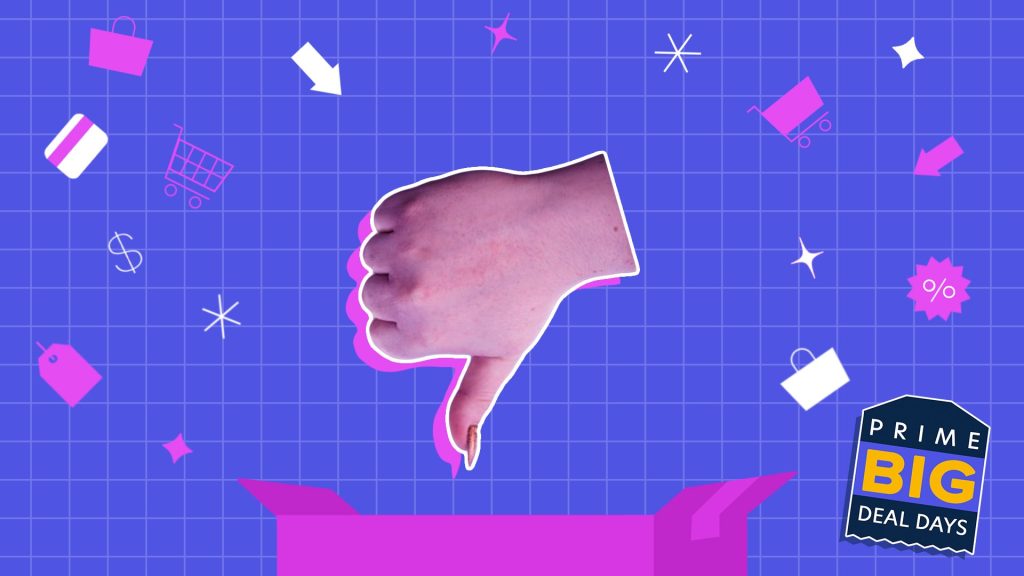Amazon will dish out millions of discounts during Prime Big Deal Days, its members-only “October Prime Day” sale (set for Oct. 8 and 9). But buyer beware: Not every “deal” is as good as it may seem.
It can be difficult to decipher what’s worth your hard-earned cash and what’s better to pass on, so allow the Mashable Shopping team’s experts to impart some advice. Keeping scrolling for our guide to things you should avoid on Amazon during Prime Big Deal Days.
Any deal that seems too good to be true… probably is
There are a few ways you can check if an item’s sale price on Amazon is a legitimately good deal that’s worth adding to your cart. One is by cross-checking the listing with its manufacturer’s website to verify its MSRP; Amazon will occasionally inflate them to make discounts look steeper than they really are. We also recommend cross-checking sale prices at competing retailers like Walmart, Best Buy, and Target, which will sometimes match or beat Amazon’s offers.
Credit: Screenshot: Amazon.com
Credit: Screenshot: Acer.com
The Amazon price-tracking website camelcamelcamel is an especially valuable tool during sales like Prime Big Deal Days. If you plug a product’s Amazon listing into the search bar at the top of its homepage, you’ll be able to see the products’s going rate(s) over the weeks/months/years. The site occasionally misses short-term discounts, but it can give you a good general idea of whether or not a discount you see is actually as impressive as it seems.
Take this Rockland luggage set, for instance. In September 2024, Amazon put it on sale for $97.26, making it appear to be 56% off a $219 MSRP.
Credit: Screenshot: Amazon.com
However, when we entered the luggage set’s URL into camelcamelcamel at the time, we saw that it’s rarely ever listed for that full price. In fact, it’s been hovering around the $90 to $100 mark for literal years. That puts its discount in a different context.
Credit: Screenshot: camelcamelcamel.com
Here’s another example: At $189.99 (down from $249), this seems like a great deal on the Apple AirPods Pro 2, right?
Credit: Screenshot: Amazon
While they are a decent buy, camelcamelcamel tells us the AirPods 2 are regularly discounted to this price, so there’s no need to jump the gun. In fact, it’s worth waiting a few more weeks in case they return to their all-time low of $168.99 during Prime Big Deal Days.
Credit: Screenshot: camelcamelcamel.com
Impulse buys: Just say ‘no’
Just because something is on sale doesn’t mean you have to buy it. Seriously. Yes, those dirt-cheap Echo Pops are pretty dang tempting, but do you actually, desperately need a new smart speaker?
Sure, FOMO is real, but so is buyer’s remorse. In a 2023 Google survey of U.S. adults, nine out of 10 respondents said they’ve experienced buyer’s remorse from impulse purchases, while 42 percent said they’ve regretted buying something simply because it was on sale.
We recommend going into Prime Big Deal Days with a list of things you actually want or need and abiding by it religiously.
Be cautious of products sold and shipped by third-party sellers
It’s safest to stick to products that are sold and shipped by Amazon rather than an independent third-party merchant. While many of them are selling legitimate products — and Amazon does a lot to combat counterfeits — too many of them aren’t. They may also have different customer service options than Amazon.
The retailer’s roster of third-party sellers does include some official storefronts of verified brands, which are generally legit. However, it bears mentioning that we’ve encountered at least one instance of an unauthorized seller posing as a real one, complete with the same name and branding.
Ultimately, we don’t think it’s worth the hassle of combing through an unfamiliar seller’s entire review history for potential red flags when there’s a huge selection of deals from Amazon itself right there. It’s also just not worth taking any risks when your money is on the line, no matter how small they may be. It’s OK to be overly picky, especially when it comes to tech and other major purchases you might be making during a once-a-season sale. (Think about it this way: Would you feel more comfortable dropping several hundred dollars on a laptop sold by Amazon or something called “Mall of Americ (SN Recorded)“? Typo theirs, not ours.)
You can find out who’s selling an item you’re interested in by visiting its product page and looking just below its “Buy Now” button on the far right side. If you see two lines indicating that it “Ships from Amazon.com” and is “Sold by Amazon.com,” you’re good to go.
Credit: Screenshot: Amazon.com
Credit: Screenshot: Amazon.com
In the off-chance you ever find yourself in a situation where you think you’ve accidentally bought a counterfeit item or a seller isn’t responding to questions about an order problem, know that you have some recourse under Amazon’s “A-to-z Guarantee.” It does involve a whole eligibility and claims process, though.
Last, but not least: Stay away from Ring camera deals
We always see a ton of Ring deals pop up during Prime events, but we don’t recommend buying any of the Amazon brand’s home security equipment if you like your privacy and your neighbors. The company’s recent history is mottled with security and data handling issues, including sketchy law enforcement partnerships. (It finally shut down the tool that let police publicly request footage without a warrant earlier this year, but it’s not that far in our rearview mirror, and we’re still skeptical.) To quote the great Randy Jackson: “It’s a no from me, dawg.”







